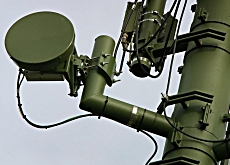Phone radiation “affects biological processes”

Electromagnetic radiation produced by radio antennae or mobile phones can affect biological processes, such as electrical brain activity during sleep, say researchers.
But a wide-ranging Swiss study has not been able to establish any links between everyday exposure to radiation and health problems. Nevertheless potential risks are not being ruled out.
The National Research Programme “Non-Ionising Radiation – Health and Environment” (NRP 57), whose results were presented in Bern on Thursday, was the first of its kind in Switzerland.
“The concern of the population is quite substantial concerning non-ionising radiation so it was thought a good idea to launch a research programme,” Alexander Borbély, who headed the NRP 57, told swissinfo.ch.
The question of whether mobile phones – there are nine million of them in Switzerland – and the use of technologies such as wireless internet connections or cordless phones are bad for human health and the environment has long been debated.
There have been fears, for example, that high mobile phone usage could entail a cancer risk.
The four-year programme from the Swiss National Science Foundation (SNF) concluded, however, that there were “no easy answers to these simple questions”.
Brain waves
Some research projects have confirmed that non-ionising radiation affects biological processes in cells and organs.
A Zurich University team discovered changes to brain waves during sleep if the subject was exposed to the radiation of a half-hour mobile phone conversation beforehand.
However, this did not affect the different sleep phases, nor did it seemingly detract from the quality of sleep. Coffee and sleeping pills can also change brain waves, researchers said.
But another study, which collected data on mobile phone usage and exposure to radiation among the population for the first time, found an average exposure far below the set limits in Switzerland.
“The results showed that there was no relationship between health complaints and exposure to radiation in quite a large sample of more than 1,000 people,” Borbély said.
“The study was followed over one year and the absence of any relationship between exposure and health was reassuring in a sense that it is unlikely that there is a major effect.”
Pregnancy risk
However, scientists saw one action area: protection of foetuses during pregnancy.
Researchers simulated the amount of electromagnetic radiation that reaches unborn babies in the third, seventh and ninth month of pregnancy and found that the levels to which a foetus was exposed lay above the permissible threshold if the mother had maximum exposure at the workplace.
They have called for product standards for technical equipment at the work place, in particular induction cookers, to be adjusted.
Reacting to the research programme’s results, the Federal Environment Office said the radiation issue was complex.
“Those who had hoped that the NRP 57 would provide the final word on the harmfulness or not of this radiation will be disappointed because the programme couldn’t give a definitive answer,” a statement said.
“Nevertheless, it has put together important pieces of the puzzle, contributing to a universal understanding of the topic.”
Potential effects
The Environment Office said that there were still potential risks. The country already has strict non-ionising radiation limits in place, for example for overhead power lines, which are tougher than international standards.
“The Environment Office believes therefore that these precautionary limits should not be relaxed, as demanded by some quarters,” it said.
For its part, the organisation Doctors for Environmental Protection said that it was concerned about the research programme’s results. It recommended as a precaution that children should only occasionally use mobile phones. The group was also particularly worried about the effects of radiation on the brain.
Borbély said follow-up studies are needed to see how the effects detailed in the research programme, which is now finished, affected the body in the long-term.
“These are subtle effects but nevertheless they are there and they have been confirmed and so people would like to know more about how these come about and whether they have any potential health implications,” he told swissinfo.ch.
The Federal Health Office said in a statement that this kind of research was urgent.
“It would not only be a shame for the scientific community but also in terms of the protection of the Swiss population if the knowledge and efficient and precious networks in this area were lost,” it said.
From 2007-2011 researchers of the NRP 57 programme assessed the health risks posed by our exposure to electromagnetic fields and non-ionising radiation in 11 different research projects.
In the “Dosimetry and exposure assessment” module, researchers measured the electromagnetic fields produced by radio masts or mobile phones and calculated the amount of radiation absorbed by the human body; the “Laboratory studies and epidemiology” module looked at the short-term and long-term effects of non-ionising radiation; and the “Cell biology” module sought to track down molecular mechanisms of action.
Two sociological studies of the “Risk perception” module examined what the media and the public make of the risks of non-ionising radiation.

In compliance with the JTI standards
More: SWI swissinfo.ch certified by the Journalism Trust Initiative














You can find an overview of ongoing debates with our journalists here . Please join us!
If you want to start a conversation about a topic raised in this article or want to report factual errors, email us at english@swissinfo.ch.